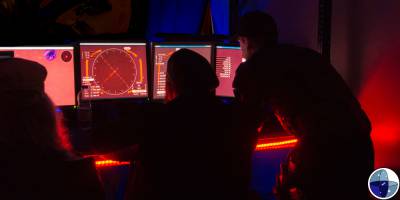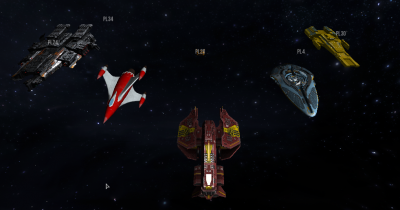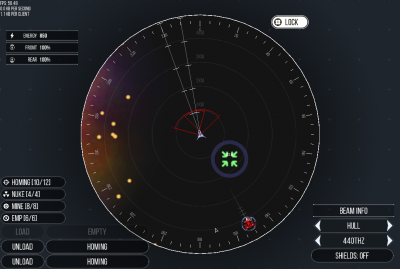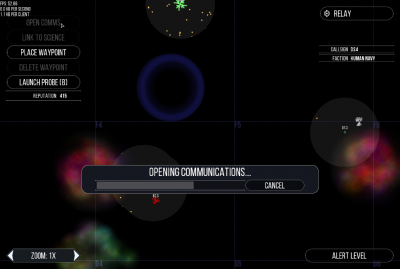Tag Cloud:
User Tools
Sidebar
Table of Contents
Starship Simulator
The Starship Simulator is one of Orion Sphere LRP’s unique elements. While not essential for all characters to get involved with, it can help to get an idea of how it works and the purpose it serves in the game.
In-Character
 At events, the Starship Simulator represents hire-able starships provided by the Spacer Collective. They can be hired in timed slots, typically 1 hour long. Although player characters can have their own starships as part of their background, these are considered to be below the abstraction layer, as only Spacer Collective ships are equipped with a Jump Drive - which allows them to travel to other star systems instantly to carry out missions. The fastest starships outside of the Spacer Collective take hours or days to travel even to neighbouring star systems.
At events, the Starship Simulator represents hire-able starships provided by the Spacer Collective. They can be hired in timed slots, typically 1 hour long. Although player characters can have their own starships as part of their background, these are considered to be below the abstraction layer, as only Spacer Collective ships are equipped with a Jump Drive - which allows them to travel to other star systems instantly to carry out missions. The fastest starships outside of the Spacer Collective take hours or days to travel even to neighbouring star systems.
The stations of a Spacer Collective ship have been designed to function in a similar way to the most common starship layouts in the Orion Sphere - so characters that are ace pilots, ship engineers etc, can easily transfer their skills to Space Collective ships - this is represented by buying Console skills with your character points.
Hiring a Starship Slot
 At events, you can book a starship hire slot by speaking with the Spacer Collective representative, who will charge you a hire fee and give you a specifically timed slot. You need to specify where you intend to Jump to when you hire the slot, so that the Spacer Collective can perform the calculations that allow the long-range Jump to occur. This means that you must specify your location a few hours before the slot happens. Although you can jump to literally any known location in the Orion Sphere (and a few beyond it), there is no guarantee that there will be anything to do when you get there. The best way to find locations where interesting and rewarding things are happening is to speak to the Clearance Organisation and find a bounty or mission that is tied to a location.
At events, you can book a starship hire slot by speaking with the Spacer Collective representative, who will charge you a hire fee and give you a specifically timed slot. You need to specify where you intend to Jump to when you hire the slot, so that the Spacer Collective can perform the calculations that allow the long-range Jump to occur. This means that you must specify your location a few hours before the slot happens. Although you can jump to literally any known location in the Orion Sphere (and a few beyond it), there is no guarantee that there will be anything to do when you get there. The best way to find locations where interesting and rewarding things are happening is to speak to the Clearance Organisation and find a bounty or mission that is tied to a location.
When you book a slot, you can also pay additional chits for add-ons and upgrades to your hired ship. This can range from extra probes, torpedoes or coolant all the way up to a powerful nuclear torpedo! The Spacer Collective also has special ships customised for each Faction that have different abilities to the normal model of starship - groups can pay or build up Reputation with the Collective to gain access to these custom ships.
The long-range Jump Drive transports starships to a Jump Point, usually located near a system’s primary star - ships that travel by Warp Drive tend to arrive at the edges of a system instead. In most missions, in order to safely jump back to the event system you must return to the Jump Point that you arrived at. It is possible to make a long-distance jump away from the Jump Point, but it is less safe and characters might sustain jump-related injuries or Conditions. Starships can also use their Jump Drive to make short-range jumps within a star system. These jumps do not require the massive calculations that long-range jumps require, and do not require a jump point to be safe - they just drain some of the ship’s energy reserves.
You are restricted by the length of your hire slot - if you go over your allotted time, you will receive several warnings, and eventually the starship will perform an emergency long-range jump back to Spacer Collective station in the event system. Injuries and afflictions are very common when this happens. Similarly, if your ship is destroyed, the crew will usually be encased in protective stasis fields and picked up after a short time by a Spacer Collective Retrieval drone. Although the stasis fields are a useful failsafe, they are not perfect, and it is common to receive injuries such as burns, decompression, radiation exposure or other afflictions as the ship disintegrates. Crews are also liable if their hired ship is destroyed, and may be asked to compensate the Collective in some way.
OSLRP_Digital events can be a little bit different - some scenarios might represent historical events, or crews flying their own or Faction starships. Each scenario will vary, but the default is what has been described above. Digital scenarios are already committed to a specific mission or task - you start the scenario having jumped into the location that the scenario takes place, and the scenario ends if you complete the mission or jump out.
Out of Character
 At Orion Sphere LRP events, the starship simulator serves as both a way of enabling off-planet missions and a fun thing to do in its own right. As a way of facilitating off-planet missions, it acts as a limiting gateway that allows the game team time and warning to set up for the missions you want to do in advance, and an IC explanation of why only one or two linears can happen at a time.
At Orion Sphere LRP events, the starship simulator serves as both a way of enabling off-planet missions and a fun thing to do in its own right. As a way of facilitating off-planet missions, it acts as a limiting gateway that allows the game team time and warning to set up for the missions you want to do in advance, and an IC explanation of why only one or two linears can happen at a time.
Slots must be hired in advance and a location specified so that the Game Team can prepare a space mission or linear to fit the overall plot of the game. Since there are a limited number of ship slots available, and they are in high demand, we have to be quite strict on their timing and use - your slot starts when it is scheduled to start, and finishes when it is scheduled to finish. The Emergency Jump feature is designed to penalise crews who take too long on missions, and adds urgency and tension to excursions outside the main play area.
Character Skills are input each mission by the Relay Console, once the option has been enabled by the GM. Players with characters in the game already will usually use the character skills they have purchased. At Digital events, players who are playing temporary characters or characters who have not yet attended a main event (and so don’t fully “exist” on the system) are assumed to have fully purchased all of the skills relevant to their chosen Console.
OSLRP_Digital
Digital events have less of the logistical concerns of main events, and are an opportunity to tell more interesting and varied stories using the simulator software. Digital scenarios are often designed to add narrative and flesh out the setting a bit more - they allow characters to explore bits of the setting that their character might not normally interact with, or build stories that their characters can take forward to other events.
Many aspects of the game are handwaved to make the starship mission the core of the experience - hire slots, payment, rewards etc are all less important or nonexistent in a Digital event. See the OSLRP Digital Notes for more details.
What to Expect from the Starship Simulator
The Starship Simulator is basically a computer game. It is run from a central server, which each Station connects to in order to control their part of the ship. Everything outside the ship is controlled by the GM, which will be a member of the Game Team (at events normally one of the Spacer Collective NPCs). The GM can create ships, natural phenomena, the environment, etc in the game, and tweak their attributes and move them around. The software we use is Empty Epsilon, an open source bridge simulator, that has been extensively customised by the UK Starship Bridge Simulator group to do what we need for OSLRP. While a lot of things, like system creation, character skill integration, etc are mostly automated now, there are still a lot of things that the GM is doing on the fly to keep the scenario going and keeping it a challenge, but not impossible.
At events, the rigs we use are provided by UK Starship Bridge Simulator, and they set up, run and manage them for us. Since it is tech, occasionally it fails or has bugs, but hopefully nothing too game-ruining. For Digital events, we will send out a link for players to download the software, and usually help people out with connection and the basics of using the consoles. The software is pretty basic, so doesn't require an amazing PC to work, but unfortunately only runs on Windows (there is an Android version of Empty Epsilon, but it hasn't been tested with our custom version and its impossible to alter the Google Play Store version).
“The fun” of the starship simulator is working together as a team to overcome challenges. It isn't really designed to simulate betrayals by members of the crew, complex interactions with the environment or anything like that. At main events, there is certainly scope for that sort of thing in in-character locations (and the bridge of the ships are in-character locations), but the software, though flexible, is still limited in what it is able to do.
The Consoles
There are 6 different consoles/roles on the starship simulator, plus a number of other ones that may be available depending on the situation. Players can take responsibility for more than one role at a time, although this is more practical with some combinations than others. The most common is for the Captain to also use a console, as the Captain normally has no console of their own. Each console functions in its own specific way, although they can be compared relative to each other in certain terms. At a minimum, every ship will usually require at least 3 crew, maybe 2 if they are very skilled and good at multitasking.
Captain
- Coordinates the rest of the crew
The Captain does not have a console by default. Their role is to maintain an overall idea of what is happening on the ship, listen to the rest of the crew, make decisions and give orders. The Captain coordinates the rest of the crew so that they can work effectively together. Optionally, the Captain can make use of the Strategic Map or a few other ancillary functions to keep up with what is going on.
Helm
- Flies the ship
- Middle Focus
The Helm station determines where and how the ship moves. It has a short-range radar, so is not capable of seeing distant objects, but it can zoom in very close to maneuver effectively in combat. Helm can change the ship’s direction, use its impulse, warp and jump drives, and generally move the ship around. Helm is one of the two most important consoles in combat - a skilled Helm will be able to stay out of enemy fire arcs while keeping their ship’s own beams trained on the opponents.
Weapons
- Middle Focus
The Weapons station targets enemies with beams and torpedoes, loads and empties the torpedo tubes, controls the shields, manages weapons supplies, and works with the Science console to calibrate their beams and shields for combat. They can target specific enemy systems to knock them offline, or just target their hull to blow them up. Weapons needs to work closely with Science and Helm, and listen to the Captain’s orders - in combat it is easy for Weapons to become hyper-focused on efficiency and lose sight of the big picture.
Engineering
- Keeps the ship running
- Very inward-focused
Engineering is the most inward-facing station. It has no information about what is happening outside the ship, so can be easily overrun by changing circumstances if not paying attention. Engineering controls the ship’s systems, diverting power to systems that are in use, and away from ones that aren’t to preserve the ship’s energy. Overpowered systems overheat and can damage the ship, so they also have a limited supply of coolant that can be used to keep that under control. Being a successful engineer is like keeping many plates spinning at once, listening to what the rest of the crew are doing and providing or removing power in response to their needs.
Science
- Gathers information
- Very outward focused
Science is one of the most outward-facing stations. It has a long-range radar, so can see the furthest of any console, and can scan things for more information, and to find out their weakest beam and shield frequency. They have a database of ships and stellar phenomena that they can look up. Science has no way of interacting with anything in the simulation apart from gathering information and passing it on to other crew members, so it is important for them to communicate the information they gather.
Relay
- Communicates, hacks other ships, assists with navigation
- Mostly outward focused
Relay is also very outward-facing. The Relay station communicates with other ships, which can be very important for identifying and achieving mission objectives. They have a strategic map view, and can identify grid locations and place waypoints that the Helm can follow. They have a limited supply of probes that can be launched to parts of the map and the Science console can then use to scan distant areas (although these probes run out of power after a while). Relay can also Hack enemy ship’s systems to knock them offline for a while, which is very useful when taking on powerful ships. In some scenarios, Relay can launch drones - small autonomous ships that they can give basic orders to.
Drone Pilots
- Fully control small drones
- Not always available
Only certain scenarios will have access to Drones, which extend the crew beyond the standard 5-6 players. Drones are small, fast ships equipped with a beam weapon, that act independently of the main ship. Although the pilot has full control over the Drones’ movement, power and weapons, they possess no scanner or hacking system, and other ship abilities are limited. Drones have a short vision range, the same as the Helm and Weapons consoles, but can share the main ship’s strategic map. Drones can be used to extend the ship’s reach, scouting distant areas, taking on small fighters or ganging up with the main ship against larger foes. Successful Drone pilots are able to act on their own initiative, work with the rest of the crew when necessary, and be aware of the limitations of their Drones. The ship has a limited supply of Drones, so can afford for a few to get destroyed.


